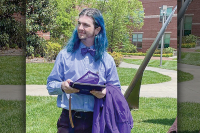Use Eagles if Necessary, Chapter 25: The Final Session
It’s almost time for resolution and termination but first some last minute housekeeping. You should know that I do not believe Adam and Eve are historical people. I was taught Darwin’s theory of biological evolution by the Jesuits and that’s how I perceive life on our planet. That is also Rome’s official position. I also believe in the theory of spiritual evolution convincingly put forth by the paleontologist Pierre Teilhard de Chardin, S.J. (It’s a toss up, however, to see which is moving at the slower pace.)
But Adam and Eve metaphorically suited my purposes so I used them throughout the book. Everybody in Western Civilization knows their story. Psychoanatically speaking, they were the first “Undoers.” They had it made in the Garden of Eden. There was only one thing God forbade them to do and, of course, they did it. Their first two children engaged in the first sibling rivalry. It ended in murder. The Adam and Eve Family was dysfunctional.
Nor do I believe in the Devil, although I used him also. The Devil is merely a scary symbol, or concept, to describe that part of every unconscious mind which is self-serving, greedy, spiteful, hateful and malicious — words we use to describe evil. The Devil’s real name is not Beelzebub or Lucifer. It is the Id.
I do believe in God but wouldn’t attempt to describe this Being except to say that Love, Beauty and Truth emanate from that Existence. I believe we humans are drawn toward a relationship with God, but I’ve only the tiniest grasp of what that means. (And the Id diligently discourages that quest.)
Because I believe in God, logic demands I believe in a life hereafter. This life is so incredibly unfair to so many people. God must, then, make adjustments for that reality. And I believe in miracles.
My psychoanalytic colleague, Dr. Margery Quackenbush of New York, wrote her PhD thesis on the exciting new field of neuroscience. In her thesis she states (I paraphrase) that it has been found that psychotherapy alone — without accompanying medications — can positively alter brain functions. “Psychotherapy can re-wire the brain,” she writes. In other words, a spiritual interaction — where only words are exchanged between two people in a caring environment — can alter the workings of a physical organ. That’s a miracle.
Related Items
At the Lucy Daniels Center, a psychoanalytic institute in North Carolina, I heard the well-known psychiatrist, psychoanalyst and author, Glen Gabbard, MD, state the same thing, adding that newly devised monitoring equipment scientifically proves it. That is wonderful news for us talk therapists, and our patients, although we’ve always believed this was so.
The temptation, then, would be to declare war on drugs and throw them out. But, for at least three reasons, that would be stupid: 1) The depths of psychotherapeutic treatments vary dramatically. 2) The expertise of psychotherapists vary even more dramatically. 3) Medications work. They, too, can positively alter brain functioning, and they can do it a lot faster than therapy.
When I began analytic training we were taught that medications for almost all mental problems were not only unnecessary but were actually cop-outs. Traditional analysts thought that mental illness could be talked away given enough time, the proper setting, and a solid connect between analyst and analysand. Only the most seriously ill would be allowed drugs. For many years I believed this (I only resorted to them once), but not anymore. Medications are not always a cop-out. Sometimes they are absolutely necessary for a patient to get better.
Medications available today can lift depression, control mania and stabilize moods often in just a few days. To not use them in certain instances would be cruel to the patient and irresponsible on the part of the therapist. Certainly “Tom the doctor” and the patient who looked like a terrified horse would have benefited from medication to get them talking coherently — and sooner. They had suffered long enough.
But it is important to keep in mind that medications alone will not cure mental illness anymore than insulin cures diabetes. They merely keep the condition in check. And I would never consider using medications alone. A pill’s properties do not include insights and they can not make interpretations — the stuff of permanent healing and growth.
Nor do medications even remotely imply a connection with another soul. If done properly, the therapeutic relationship will be the deepest and most personal relationship someone will ever have, which is probably (in the final analysis) the main healing force. It is the ultimate validation — the ultimate butt saver.
As to the causes of mental illness, I am a believer that most are environmentally based. After reading this book you certainly know that. But there are other factors to consider. Let’s return to words from Dr. Quackenbush: “We are just beginning to explore the structural organization of the brain ... instead of distinguishing between mental disorders along biologic and non-biologic lines, it might be more appropriate to ask ... to what degree is the biologic process determined by genetic and developmental factors, to what degree is it due to infections or toxic agents, and to what degree is it socially determined?”
Fair enough. We still have a lot to learn. But in the meantime let’s hear about the patient’s mom and dad. Even if they’ve nothing to do with his emotional problems, we’ll learn more about the total person.
A little more housekeeping. I have not been overly kind or gracious to my fellow mental health professionals. Let me set that record straight. Most I know are good, solid, caring people who are trustworthy and know what they’re doing. But the field does indeed attract some goofy people. Recently I was on a small cruise boat for a week with perhaps 50 passengers. On the first night one of them confided to me: “I’m a psychotherapist, but don’t tell anybody. I don’t want people bothering me, while I’m on vacation.” (I didn’t tell her I was an analyst.) She got drunk every night and by the end of the week had “confided” this tidbit to the other 49 people on board. They were laughing about it behind her back. She was goofy.
On the other hand being goofy is not always bad. I have a professional artist friend who most people would consider strange. (Of course he’s strange — he’s an artist.) We hadn’t been in contact for many years but recently reconnected. I asked him if he’d been helped by psychoanalysis some 20 years before. I knew his analyst, who was also strange in his own way. “Yeah, he helped me a lot. It takes a crazy fucker to help another crazy fucker,” he said. There’s truth there.
The mental health community is splintered into numerous schools of thought, each believing they’ve got “the answer,” mirroring my experience with my Goddard College classmates of years ago. These schools are a parochial bunch and quarrels are frequent. This doesn’t bother me, there’s nothing wrong with scholarly fights, and good ideas may result. I’m glad Carl Jung broke with Freud, for instance. What does bother me is that many psychological schools concentrate solely on conscious thought and behavior, which are symptoms of deeper problems. They treat them and stop. They seemed to have lost the knack, or knowledge, to get into the unconscious mind of their patients where causes dwell. That’s a dangerous trend away from psychic reality and seems to be an embracement of society’s reality. You know, shallow. Treating symptoms merely creates different symptoms. The causes remain, firing away, not really caring how they are manifested. If people go through life in touch with their conscious minds only — they have missed much of the journey.
More housekeeping: A word to my real patients, who know who they are. You allowed me to participate in your most private, intimate thoughts and feelings. You humbled me by your trust. As the years go by, and I reflect on our times together, that humility deepens and, as you may recall, humility was not one of my virtues.
I know that some of you would not have minded seeing yourselves in the book — even by name — and having your therapy sessions described in detail. Some of you would have loved it. I couldn’t do that, of course. However, you are all in the book in essence. You were my ultimate teachers, not only validating my academic training, but my own analysis as well. You proved to me we that we all share commonality in our unconscious minds. You enriched my life, and for that I will be forever grateful.
I am also grateful to my four, core “people” superego figures: Mom, Dad, Mary and Bob. Never for a second, even in the most intense part of my personal analysis, did I ever feel you didn’t love me. And never for a second did I not love you back. My concept of you was altered, for sure, but not my love. That’s mighty good stuff. I’m glad you’re mine.
Now to you, God, my fifth superego. As you know you are a transference figure because your grandeur makes you inconceivable to us. The way we must envision you is by picking people we know and respect (or, in some cases, fear) and then ascribing their personalities on to you. But you are a transference figure who changes. During my life you have seemed like the mean grouch who lived across the street; the unbending nun who taught phonics; the world wise Jesuit at John Carroll who enjoyed his vodka martinis (perhaps a little too much); my fearless commanding officer in Vietnam; and my psychoanalyst. As I have changed — you have changed. Today you’re my grandfather.
Bapa was the kindest of men. He was gentle and generous and knew when to weep. The fact that he smoked cigars and said bad words only made him more human — which made him more real. And that’s what I’m trying to do with you, God. Make you more real. But that is one, tough, life-long challenge and I’m still working on it.
OK, that’s it for housekeeping, and I’ve said what I wanted to say in this book. Please remember that even though you’ve read it from cover to cover your emotional system has not been improved. If you think it needs improving there’s only one way to do that. See a shrink. One who cares. One who listens.







